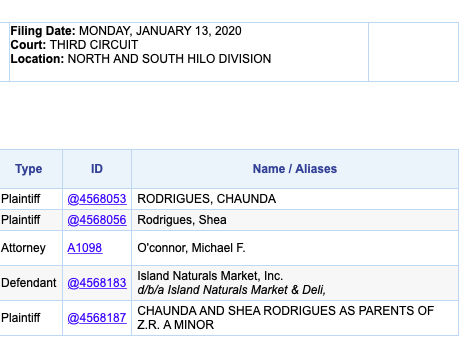Correction: Argon Steel, Ph.D., informed Environment Hawai`i that the bleach solution used in testing possible effective vegetable washes was household bleach, which was diluted 25 percent, so the actual dilution was 1.5 percent bleach. Also, the chlorine that was used in testing was chlorine dioxide.
Just days before the 6th international workshop on rat lungworm convened last month, rat lungworm was in the news. On December 31, a customer at Island Naturals, a health foods store in Hilo, had found a half-eaten slug in one of the two sandwiches she had purchased there.
Less than two weeks later, the woman and her husband, Chaunda and Shea Rodrigues, and Z.R., their 13-month-old son with whom Chaunda had shared her sandwich, filed a civil suit against the store, seeking unspecified damages. The lawsuit alleges a “manufacturing defect in the sandwich products,” negligence, and a breach of implied warranty. They seek general and special damages, among other things.
According to the lawsuit, “after consuming approximately half her sandwich, Plaintiff Chaunda took another bite and felt something stick in her top left jaw. She removed the item from her mouth and discovered it was a 2.5-inch slug. She inspected the rest of her sandwich and found the other part of the slug still inside. The realization of what she had consumed caused her to vomit.”
On January 1, Chaunda went to the emergency room at Hilo Medical Center, where she was prescribed Albendazole. The following day, she took the “entire plate with the slug (frozen within three hours of the incident) to the Jarvi Lab” at the Daniel K. Inouye College of Pharmacy at the University of Hawai‘i-Hilo. There the slug tested positive for the presence of rat lungworm DNA.
According to the lawsuit, both Chaunda and Shea experienced some health effects. However, after taking Albendazole for a week, the symptoms have dissipated, Chaunda told Big Island Now web news on January 19.
When the incident was first publicized in early January, Island Naturals owner (and state senator) Russell Ruderman apologized. “Among the many things we’re doing as a result is we’ve revised our safety precautions, but we’re also going to stop using local leaf lettuce in any of our kitchens,” he said in a statement to news outlets.
In attempting to explain how the slug got into the sandwich, Ruderman said that the store was unable to obtain lettuce from its usual supplier. A kitchen worker decided to take lettuce from the store’s produce aisle and then washed it inadequately before using it.
But what constitutes an adequate vegetable wash?
Argon Steel, a researcher at the Daniel K. Inouye College of Pharmacy at the University of Hawai‘i-Hilo, presented the results of a study he and colleagues had done of more than 40 different proposed vegetable cleaning treatments. The testing was in vitro, meaning that rat lungworm larvae were exposed to the washes directly to see how they responded over a period of seven days.
They tested three categories of treatments: common household products; consumer vegetable washes; and commercial crop washes. Commercially available “veggie washes,” Steel said, showed little ability to kill the larvae. Salt water, Epi-Clean, and botanical extracts such as those made from ginger, garlic, or moringa, had practically no effect. Crop washes “don’t take effect quickly and aren’t terribly effective,” he noted.
Some of the stronger alkaline solutions – such as a 25 percent bleach solution (household laundry bleach is less than one third as strong) and chlorine – were effective, as was dodecylbenzene sulfonic acid. All are health hazards. None of them is available to the average consumer. (See correction note at the beginning of this article.)
One of the difficulties researchers facedwas determining just when the larvae are dead. Often they will become immobile when exposed to chemicals. “But loss of motility is not a measure of mortality,” Steel said. “It could indicate just a temporary quiescence in response to stress.” The chemical propidium iodide was used to tell the difference between dead larvae and those that were merely knocked out.
Given the lack of effective wash treatments, Kay Howe, who has developed programs to educate the public about rat lungworm, recommends cooking or freezing locally grown produce, to be safe. “Any foods that are to be eaten raw should be easy to peel or clean and dry well, like tomatoes and peppers,” she said.
(Howe became an expert in the disease after her son became gravely ill in 2008. In recognition of her efforts, the audience at the workshop gave her a standing ovation.) — Patricia Tummons


Leave a Reply